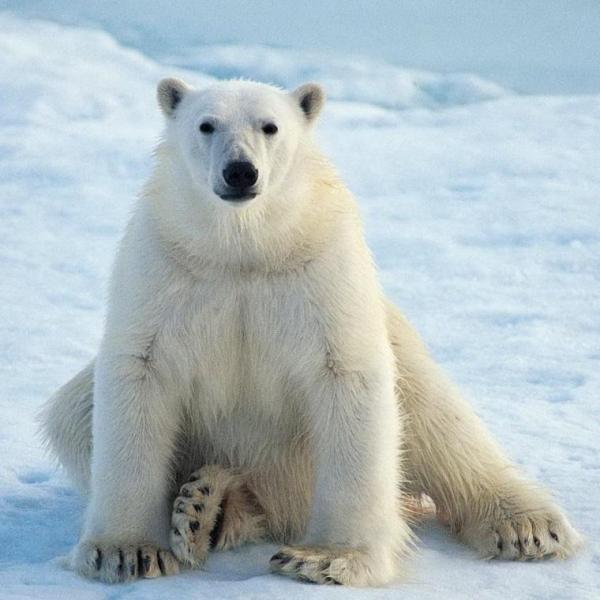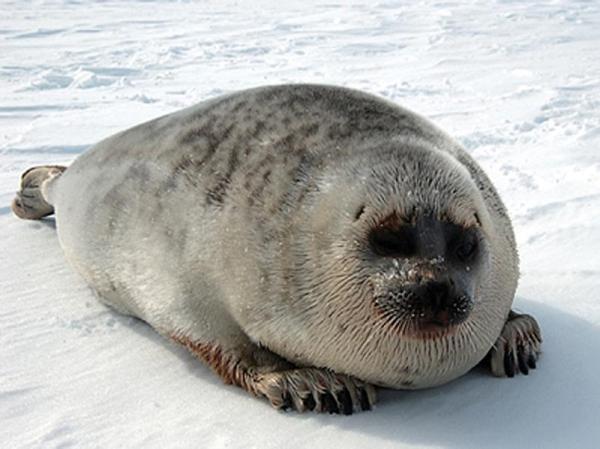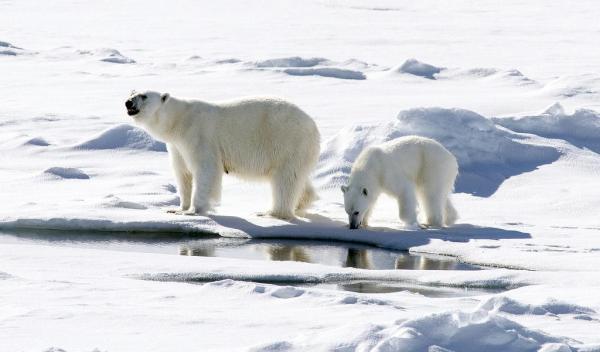
Polar bears (Ursus maritimus) live in the frozen regions of the Northern Hemisphere, in the Arctic Circle. There is currently an estimated population of 20,000 polar bears, and their numbers have fallen drastically in recent years.
These bears have solitary habits and don't hibernate, except for mothers with cubs. In this AnimalWised article we will discuss a polar bear's diet, their main prey and their eating habits. You will also learn about the threats which they are exposed to nowadays.
If you want to know how do polar bears survive in such a cold environment, read our article on how do polar bears survive the cold. As an advance, the polar bear's diet is just one of the many ways they have evolved.
How much do polar bears eat?
Polar bears are one of the largest land mammals in the world. Adult male polar bears weigh at least 350 kg (770 lb), although they can get to even 700 kg (1540 lb), and they measure up to 3 m (9'10'') long, although female polar bears are slightly smaller.
Polar bears are carnivores. Other species of bears incorporate numerous fruit and vegetables into their diets; polar bears, owing to the harsh region they inhabit, only occasionally eat vegetables during the Arctic summer. In other words, they are the most carnivorous bears on the planet. Such a big size means that polar bears need huge amounts of meat and fat to live, approximately 30 kg (66 lb) daily. This diet is crucial for maintaining their thick layers of blubber, which insulate them against the extreme cold.
Polar bears don't drink water. The only available water in their surroundings is saltwater, so they need to get fluids from the fat and blood of their prey, which humans wouldn't be able to metabolize. This adaptation is essential for their survival in the Arctic environment.
The eating habits of polar bears vary throughout the course of their life. Young bears mainly consume meat from prey, while adults consume the fat and skin of the animals first. This preference helps adults store energy and maintain warmth in their bodies, particularly during the leaner months.

What do polar bears eat?
- Seals: These are the preferred prey of polar bears, and they have the largest population in the Arctic. Seals are high in fat, and some species can weigh up to 350 kg (770 lb). Polar bears feed on ringed seals (Pusa hispida) and bearded seals (Erignathus barbatus), which can give them energy for a week. At the end of summer, the seals leave the Arctic and the bears lose their main source of food. This seasonal migration challenges polar bears to find alternative food sources or rely on stored fat.
- Walruses: Young or injured walruses are hunted when they rise to the surface. Walruses are formidable opponents due to their size and tusks, making them less common prey.
- Beluga whales: These cetaceans are common prey of polar bears. Although belugas are challenging to catch, their blubber provides significant energy.
- White-beaked dolphins: It has recently been noted that white-beaked dolphins are also hunted by polar bears. These dolphins approach the Svalbard waters in the summer and can become trapped in the ice. This opportunistic behavior demonstrates the bears' adaptability in response to changing prey availability.
- Land-based prey: Although they primarily hunt marine prey, they can sometimes hunt wounded or sick Arctic foxes or other animals. Polar bears aren't as fast on land than in the water, so they don't usually waste much energy on land-based prey. However, land-based prey can be a crucial food source when other options are scarce.
- Carrion: If a polar bear finds the remains of an animal, it will consume them even if they are rotting. They are occasional scavengers, although they prefer fresher meat. Scavenging allows them to conserve energy, an important strategy during lean times.

How do polar bears hunt?
Polar bears trap their prey using their keen sense of smell. When seals or beluga whales come to breathe at the surface, they beat them and drag them out of the water using their claws. Even though polar bears swim very well and for long periods, they prefer to face their prey on the ice, where they have the advantage. Their large paws are adapted for swimming and walking on ice, providing them with stability and power.
Polar bears can attack individuals in breeding areas on the coast: They will first attack young or wounded specimens. This selective hunting strategy increases their chances of success while minimizing energy expenditure.
This species is the dominant or apex predator of the region. Sometimes groups of Arctic foxes follow them to feed on the remains they leave behind. Besides human beings, polar bears have no natural predators. Their dominance is a crucial aspect of the Arctic ecosystem, as they help regulate the populations of their prey.

Cannibalism among polar bears
The lack of prey can occasionally lead to cannibalism among polar bears. Adult males have been observed attacking younger members of their species. Global warming, which is destroying the ice in the Arctic and thus decimating the polar bear's hunting grounds and causing them to starve, may be causing the polar bear's behavior to change, leading to cases of cannibalism. This behavior underscores the dire circumstances polar bears face due to environmental changes.
Male bears, not only of the polar species, attack the young so that females enter heat earlier. This may be a phenomenon that, while cruel to our eyes, naturally occurs in the wild. Brown bears and lions, for example, have also been spotted doing this. Such behavior is a natural part of their reproductive strategy, ensuring the continuation of their genes.
This does not mean that polar bears are always cannibalistic; on the contrary, these cases of cannibalism in polar bears are rare and isolated incidents. It serves as an indicator of the pressures facing these majestic creatures.

Current situation of the polar bear
Although hunting was one of the main threats to the polar bear in the past, their biggest threats are currently pollution and the loss of their natural habitat. The accumulation of pollutants in the Arctic, such as heavy metals and persistent organic pollutants, further exacerbates their plight by affecting their health and reproductive success.
Global warming has caused huge masses of ice to disappear in the Arctic regions. The melting of icecaps has forced the polar bear to leave its normal habitats; adapting to new environments takes generations, and global warming is going too fast for polar bears to keep up. The rapid loss of sea ice directly impacts their ability to hunt and store the fat reserves necessary for survival.
Polar bears are forced to travel long distances and sometimes get trapped on small drifting islands of ice. The habitat where they once lived used to be formed by huge blocks of ice, but now it's become a large body of water with small islands. This means polar bears have to swim for longer distances. And, while they are excellent swimmers, it makes them consume a lot of energy. The increased energy expenditure can lead to malnutrition, especially for young cubs who are more vulnerable.
Young polar bear cubs suffer much more in this situation, but quite recently pictures have been taken of malnourished adult polar bears. This is a reflection of the extremely harsh situation that polar bears are currently facing. The destruction of their habitat will cause a steep decline in the population in the coming years if the situation does not improve, and they are now a vulnerable species. Conservation efforts are critical to ensure their survival, and international cooperation is required to address the challenges posed by climate change.

If you want to read similar articles to A Polar Bear's Diet, we recommend you visit our Healthy diets category.